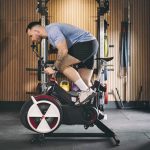The American Council on Exercise (ACE) said an independent study on Vibram FiveFingers found the while the glove-like shoes may be beneficial for those who suffer from chronic running injuries, using Vibrams and barefoot-style shoes for running can pose additional risks if runners do not adopt the correct foot-to-ground strike style. The independent study was conducted by the University of Wisconsin, La Crosse, Exercise and Health Program, and led by John Porcari, Ph.D., and Caitlin McCarthy, M.S.
The study evaluated 16 healthy, injury-free female subjects, ages 19 to 25, all of whom were considered recreational joggers. Prior to the beginning of the study, each subject was fitted with a pair of Vibram FiveFingers Bikila, which are specially designed for running. For two weeks prior to the test, the subjects wore the shoes while running three times a week, for 20 minutes per day, to become accustomed with the new shoe style.
After the two-week acclimation period, participants returned to the lab for 3-D motion analysis and measurement of ground-reaction forces as they ran under three different conditions. Subjects were measured as they ran on a 20-meter runway while wearing Vibrams, while wearing a pair of neutral running shoes and while running barefoot. Each participant completed seven trials per condition; the order was randomized between the Vibrams and the running shoes, but the barefoot condition was always measured last.
Following the tests, researchers noted that all of the subjects were rear-foot strikers when wearing the neutral running shoes, but half of the group switched to a forefoot strike pattern when wearing Vibrams or while running barefoot. The other half of the group maintained the same rear-foot strike pattern throughout all of the conditions.
Those who adopted the forefoot-strike style showed greater plantar flexion, which appears to allow better absorption of the impact forces of running. The members of the group that continued to use a rear-strike style when wearing Vibrams or running barefoot experienced a higher rate of loading, and measured higher load rates than when wearing the typical running shoes. Researchers noted that all participants experienced reduced knee flexion, which is typically associated with lower injury rates, when wearing Vibrams and running barefoot. It was also observed, however, that Vibram wearers showed greater pronation, similar to that when running in regular shoes, which may increase the risk of some overuse injuries of the lower extremity.
A complete study summary can be found in the latest issue of ACE Certified News, located at www.acefitness.org/getfit/research.aspx.
ACE commissioned the study to determine what happens when runners switch from their traditional running shoes to wearing minimalist running shoes like Vibram FiveFingers. Advocates of barefoot running suggest that traditional running shoes may increase a runner's risk of injury, as the shoes encourage the foot to use a heel-strike pattern, which causes more pounding and stress. Conversely, barefoot runners tend to run more lightly, landing near the balls of the feet and generating less pounding and potentially less risk of injury. Vibram suggests its product helps users simulate the feeling of being barefoot and achieve a forefoot strike run pattern while providing the abrasion protection of wearing a shoe.
“We've seen an increasing number of individuals using barefoot-style running shoes, and felt it critical to examine this trend,” said American Council on Exercise's Chief Science Officer, Cedric X. Bryant, Ph.D. “The bottom line is that runners must first and foremost modify their running style for ultimate safety and benefit, and this should be done gradually through regular practice. Once that is achieved, Vibram FiveFingers can be a safe and effective shoe for those who want to experience the feel of barefoot running.”
The American Council on Exercise (ACE) is a nonprofit organization dedicated to promoting the benefits of physical activity and protecting Americans against unsafe and ineffective fitness products and instruction. ACE sponsors university-based exercise science research and is the world's largest nonprofit fitness certifying organization.















